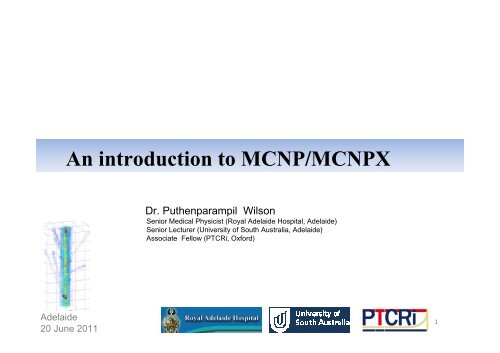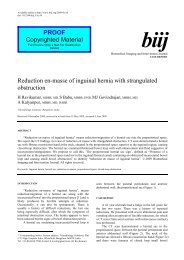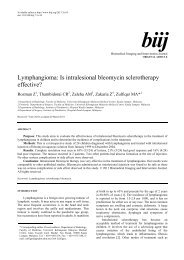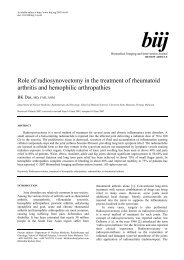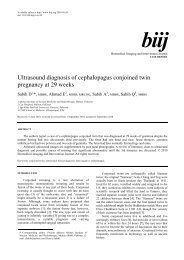Create successful ePaper yourself
Turn your PDF publications into a flip-book with our unique Google optimized e-Paper software.
An introduction to MCNP/<strong>MCNPX</strong><br />
Adelaide<br />
20 June 2011<br />
Dr. Puthenparampil <strong>Wilson</strong><br />
Senior Medical Physicist (Royal Adelaide Hospital, Adelaide)<br />
Senior Lecturer (University of South Australia, Adelaide)<br />
Associate Fellow (PTCRi, Oxford)<br />
1
A. Overview of <strong>MCNPX</strong><br />
B. Input deck format<br />
Contents<br />
C. Installation and running the code<br />
D. Applications in particle therapy<br />
2
Overview and introduction<br />
3
<strong>MCNPX</strong>- Introduction<br />
� A General Monte Carlo N- Particle transport code<br />
� Capable of tracking photons, electrons , light ions and heavy ions<br />
� 3D tracking<br />
� Wide range of energies ( keV- GeV )<br />
� Written in FORTRAN 90<br />
� Platforms: Unix, Linux, WINDOWS, OS X<br />
4
<strong>MCNPX</strong>- Introduction<br />
� Capable of tracking 35 particle type<br />
� Including 4 light ions and heavy ions (He, B,C O etc..)<br />
� Wide energy range<br />
� Photons (keV- GeV)<br />
� Electron (keV- GeV)<br />
� Protons (MeV- GeV)<br />
5
� Applications of <strong>MCNPX</strong><br />
� Medical physics<br />
� Particle therapy<br />
� Nuclear Medicine<br />
<strong>MCNPX</strong>- Introduction<br />
� Radiation protection and dosimetry<br />
� Nuclear criticality studies<br />
� Accelerator target design<br />
� Fission and Fusion reactor design<br />
� Radiation shielding<br />
6
<strong>MCNPX</strong>- History<br />
� Started the development at Los Alamos National Laboratory more<br />
than 60 years ago<br />
� 1991- MCNP 4<br />
� 2003 - MCNP 5<br />
� 2011- <strong>MCNPX</strong> 2.7.0 (Monte Carlo N-Particle Transport Code eXtended)<br />
� <strong>MCNPX</strong> 2.7.0 is the current public release<br />
� MCNP6 beta version<br />
7
<strong>MCNPX</strong>- Where can you get it?<br />
� Distributed by Radiation Safety Information Computational Centre<br />
(RSICC), Oak Ridge, US<br />
� http://rsicc.ornl.gov/CustomerService.aspx<br />
� Executables, source code and data are available<br />
� Cost- Free?(https://laws.lanl.gov/vhosts/mcnp.lanl.gov/ )- check<br />
with RSICC<br />
� Distribution is restricted –subjected to export control<br />
8
<strong>MCNPX</strong>- Advantages<br />
� Well established Monte Carlo code<br />
� Accurate model of particle transport<br />
� Requires no programming knowledge ..!☺<br />
� Initial learning curve is not steep<br />
� Can be used for large range of energies<br />
� Single input data file<br />
9
<strong>MCNPX</strong>- Disadvantages<br />
� Interface may not be great, especially for complex problems<br />
� Geometry input is difficult by the requirement to refer to objects<br />
by number<br />
� Basic text output- input deck is very specific<br />
� Distribution of the code is restricted<br />
10
<strong>MCNPX</strong> input file deck<br />
11
<strong>MCNPX</strong>- Input file<br />
� User generated input file is read by <strong>MCNPX</strong><br />
� Single input file<br />
� Format of input file is very specific<br />
� File consists of information on:<br />
� Radiation sources<br />
� Material description<br />
� Geometry of the problem<br />
� Types of results (tallies) required from simulation etc.<br />
12
<strong>MCNPX</strong>- Input file<br />
� Basic units used in <strong>MCNPX</strong><br />
� Length-cm<br />
� Energy- MeV<br />
� Time- sec<br />
� Temperature- kT<br />
� Atomic density- atoms/barn-cm<br />
� Mass density- g/cm 3<br />
� Cross section- barns (10- 24 cm 2 )<br />
13
<strong>MCNPX</strong>- Input file<br />
� Input file consists of 3 major sections<br />
1. Cell cards- define the shape and material content of physical space of the problem<br />
2. Surface Cards –defines the boundaries in space used to create cells (cylinder, sphere etc.)<br />
3. Data cards – defines problem type, source specification, materials, tally specification etc.<br />
� “Card” describes single line of input that can consists of up to 80 character<br />
� A “sections” consists of one or more cards<br />
14
<strong>MCNPX</strong>- Input file<br />
General Format<br />
Message block<br />
Blank line Delimiter<br />
Title card<br />
Cell card block<br />
.<br />
.<br />
Blank line delimiter<br />
Surface Card block<br />
.<br />
.<br />
Bank Line Delimiter<br />
Data Card block<br />
.<br />
.<br />
optional<br />
� <strong>MCNPX</strong> interprets blank line as the end of preceding information block<br />
� $ sign terminate data entry, anything follows is interpreted as a comment<br />
� If the first five columns of a card are blank, the entries on the card are<br />
interpreted as a continuation of the data from he last named card<br />
15
<strong>MCNPX</strong>- Input file – Cell cards<br />
� Cells are basic geometry unit<br />
� Cartesian co-ordinate system<br />
� Cells are defined as volumes of space bounded by surfaces<br />
� Surfaces are used to define space by combining<br />
� Sign defines surface ‘sense’ (+/-)<br />
� Variable operators- Intersections (‘space’), Union (‘:’) or complement (‘#’)<br />
16
<strong>MCNPX</strong>- Input file- Cell Cards<br />
� Cell cards- define the shape and material content of physical space of the problem<br />
� The specific cell card format<br />
j m d geom params<br />
j -cell number, an integer from 1 to 999999<br />
m - material present in a particular cell, an integer from 1 to 99999 or 0 if the cell is a<br />
void<br />
d - cell material density, a positive entry is interpreted as atomic density in units of<br />
atoms/barn-cm, a negative entry is interpreted as the mass density in units of g/cm 3 .<br />
geom – specification of geometry of the cell. Boolean operators in conjunction with<br />
signed surface numbers to describe how the regions bounded by the surfaces<br />
are to be combined.<br />
params- optional importance card<br />
17
<strong>MCNPX</strong>- Input file- Cell Cards<br />
� Cell card format example<br />
2 1 -1 -1 imp:p=1<br />
2 ���� cell number<br />
1 ���� material number<br />
-1 ���� density (in g/cc)<br />
-1 ���� cell 2 is bounded only by surface 1. surface 1 will be defined in the<br />
surface card section. Negative sign indicates that cell 2 has a negative<br />
sense with respect to surface 1.<br />
imp:p=1 ���� importance card for protons. imp:p=0 will terminate particle, normally<br />
used outside simulation cell<br />
18
<strong>MCNPX</strong>- Input file- Cell Cards<br />
� Cell card format-description of cells -another example<br />
1 +1 -2 +3 -4<br />
2 #1<br />
#1 means that the description of the current cell is the complement of the description<br />
of cell 1.<br />
y<br />
surface 1<br />
X<br />
surface 4<br />
Cell I<br />
surface 3<br />
surface 2<br />
Cell II<br />
19
<strong>MCNPX</strong>- Input file- Surface cards<br />
� Surface card- defines the boundaries in space used to create cells<br />
� Surface card – general format<br />
j a list<br />
j ���� surface number (1-99999)<br />
a ����surface type (e.g. cz- infinite cylinder centred on z axis,)<br />
list ���� number that describe the surface (e.g. radius of a sphere)<br />
20
<strong>MCNPX</strong>- Input file- Surface cards<br />
� surface card format- example<br />
100 so 60<br />
100 ���� surface number<br />
so ���� sphere centred at origin<br />
60 ���� 60cm radius<br />
21
<strong>MCNPX</strong>- Input file- Surface cards<br />
22
<strong>MCNPX</strong>- Input file- Data cards<br />
� Data Cards- defines problem type, source specification, materials, tally specification etc.<br />
� Format is similar to cell card and surface card<br />
� Some important data cards relevant to medical physics include:<br />
• Material card<br />
• MODE card<br />
• Importance card<br />
• Source<br />
• Tallies<br />
• Cut-off’s etc.<br />
23
<strong>MCNPX</strong>- Input file- Data cards-Material card<br />
� Material Card format<br />
mn ZAID1 fraction1 ZAID2 fraction2<br />
mn ���� material card number (m) followed by the material number<br />
ZAID ���� element identifier, ZZZAAA where ZZZ- atomic number, AAA-mass number<br />
fraction ���� fraction of the material/nuclide. Positive value indicates atomic fraction,<br />
negative indicates weight fraction<br />
24
<strong>MCNPX</strong>- Input file- Data cards-Material card<br />
� Material Card example- water (H 2 O)<br />
m1 1001 2 8016 1<br />
m1 ���� material number<br />
1001 ���� Hydrogen<br />
2���� atomic fraction<br />
8016 ���� Oxygen<br />
1 ���� atomic fraction<br />
25
<strong>MCNPX</strong>-Input file- Data cards- Source definition<br />
� General format<br />
SDEF source variable=specification<br />
SDEF ���� most commonly used in medical physics calculations. Often<br />
we use other three cards with SDEF, Source Information (SI),<br />
Source probability (SP) and Source Bias (SB) cards.<br />
source variable���� commonly used variables- CEL(cell number),SUR (surface<br />
number), ERG(energy-MeV), POS(reference point ),PAR<br />
(particle type from source),X-x coordinate of position, AXS-<br />
(reference vector) etc..(TABLE 5.5.1 in manual)<br />
26
<strong>MCNPX</strong>-Input file- Data cards- Source definition<br />
� source definition card example- Isotropic disc source of radius 5 cm<br />
emitting 1.2MeV photons<br />
SDEF par=2 erg=1.2 sur=101 pos=0 0 0 rad=d1<br />
SI H 0 5<br />
SP1 -21 1<br />
par 2, erg=1.2 ����particle type photons, energy 1.2 MeV<br />
sur ���� surface number on which the source is placed<br />
pos ���� position of the centre of the disc<br />
rad=d1 ���� radius of the source is defined as a distribution<br />
SI H 0 5 ���� H indicates the source distribution is a histogram<br />
SP1 ����card distribute the source evenly across the disc surface using -21,which is a<br />
built in power law function<br />
27
<strong>MCNPX</strong>- Data cards- Source definition<br />
28
<strong>MCNPX</strong>- Input-Data cards- MODE card<br />
� MODE card specifies which particle should be created and tracked<br />
MODE p1 1 ,…p1 i<br />
P1����particle designator.<br />
e.g. MODE N H E will transport neutrons, protons and electrons<br />
29
<strong>MCNPX</strong>- Input-Data cards- PHYS card<br />
� PHYS- Particle physics options. Proton physics format<br />
PHYS:H emax ean tabl J istrg J recl J J J efac<br />
emax ���� maximum proton energy limit<br />
ean ���� analogue energy limit,<br />
tabl ���� table based physics cut-off,<br />
J����unused place holder<br />
istrg ���� controls charged particle straggling<br />
recl ���� light ion and heavy ion recoil control account for the ionisation potential<br />
efac ���� controls stopping power energy spacing<br />
e.g. PHYS:H 100 0 -1 J 0 J 0 3J 0.917<br />
30
<strong>MCNPX</strong>- Input- Data cards-Tally specification<br />
� Tally card- specify what type of information user wants to gain from the<br />
calculation . e.g. flux at a point, average energy deposition over a cell, etc.<br />
� General format<br />
Fn p1 s1,s2 …., T<br />
n���� tally number.<br />
p1���� particle designator- N,P, E<br />
s1 ���� problem number of surface or cell for tallying<br />
T ���� total over specified surface or cells for F1and F2 tallies<br />
31
<strong>MCNPX</strong>- Input- Data cards-Tally specification<br />
• Tally card- example<br />
F2:N 1 3 6 T<br />
• F2 is the flux averaged over a surface<br />
• Above card specifies four neutron flux tallies, one across each of the<br />
surfaces 1,3, 6 and one which is the average of the flux across all three of<br />
the surface, T<br />
32
<strong>MCNPX</strong>-Input- Data cards- Tally specification<br />
� TMESH- The Mesh Tally general format<br />
TMESH CORAn CORBn CORCn ERGSH MSGMF RMESH CMESH SMESH ENDMD<br />
• TMESH- Graphically displaying particle flux, dose or other quantity on a<br />
rectangular, cylindrical or spherical grid overlaid on top of the standard<br />
problem geometry<br />
• Mesh tally data are written to the MDATA file at the end of each run, which<br />
can be converted into a number of standard formats suitable for reading by<br />
various graphical analysis package<br />
• CORAn,CORBn and CORCn cards describe a mesh in three co-ordinate<br />
direction as defined by mesh type e.g. CORA3 0 10i 20 for a<br />
rectangular mesh, the values define planes perpendicular to the x-axis. i<br />
enables a large number of regularly spaced mesh points to be defined with<br />
minimum entries<br />
• ERGSHn e1 e2- lower and upper energy limits for information to be<br />
stored to mesh tally n. Default –all energies<br />
• RMESH- rectangular mesh, CMESH- cylindrical mesh, SMESH- Spherical<br />
mesh<br />
• ENDMD- terminate mesh tally<br />
33
<strong>MCNPX</strong>- Processing Mesh Tally Results<br />
� Mesh tallies may be plotted with <strong>MCNPX</strong> geometry plotter.<br />
• <strong>MCNPX</strong> Z<br />
• MCPLOT>RUNTPE=filename<br />
• MCPLOT<br />
• PLOT>py 4 ex 40 or 0 4 0 la 0 0 tall2 color on la 0 0 con 0 100%<br />
� Or use <strong>MCNPX</strong> tally plotter<br />
• <strong>MCNPX</strong> Z<br />
• MCPLOT>RMCTAL=filename<br />
• Tal 12 free ik<br />
� Or post process the MDATA (MCTAL) file with GRIDCONV and then use and external<br />
package. GRIDCONV converts the data arrays in MDATA to form compatible with<br />
various external graphics package e.g. IDL,GNUPLOT, PAW etc..<br />
A useful programme: A Matlab code to import the mesh tally information contained in an <strong>MCNPX</strong><br />
mdata file (http://www.ptcri.ox.ac.uk/people/DanielWarren/ReadMData.shtml )<br />
34
<strong>MCNPX</strong> installation<br />
35
<strong>MCNPX</strong>- installation and running the code<br />
� Installation is simple for executable files<br />
� For Windows, unzip the files, create folders, place the files in the right folders…<br />
(Manual Sec 3- for details and other platforms)<br />
� Download and install an X-Server or similar software for graphics<br />
� <strong>MCNPX</strong> Execution line;<br />
� <strong>MCNPX</strong> KEYWORD=value….KEYWORD=value execution_option<br />
other_options<br />
� KEYWORD- <strong>MCNPX</strong> default filename. User may assign a specific value (file name or<br />
path), execution_option is a character or string of character informs <strong>MCNPX</strong> which<br />
of five execution modules to run, other_ option provide the user with additional<br />
execution control<br />
More Info: User Manual or http://mcnpx.lanl.gov/opendocs/installation/README.w32<br />
36
<strong>MCNPX</strong>- Installation and running the code<br />
37
<strong>MCNPX</strong>- Related software<br />
� The Visual Editor for <strong>MCNPX</strong><br />
� (http://www.mcnpvised.com/mcnpx/mcnpx.html)<br />
� Included with <strong>MCNPX</strong> 2.6 or higher.<br />
� Can be used to display, surface creation/cell creation etc.<br />
� Some detailed examples can be found in<br />
http://www.mcnpvised.com/sample_exercises/exercises/create.pdf<br />
38
<strong>MCNPX</strong>- Related software<br />
� MORITZ(http://www.whiterockscience.com/moritz.html)<br />
� Interactive geometry editor/view for <strong>MCNPX</strong><br />
� Read output from <strong>MCNPX</strong> and can visualise geometry and particle tracks in<br />
2D and 3D,write input files<br />
� SABRINA (http://www.whiterockscience.com/sabrina/sabrina.html)<br />
� Scan2MCNP (http://www.whiterockscience.com/scan2mcnp/Scan2MCNP.html )<br />
converts CR,MRI and other scan data to an input file<br />
� Codes may not be free.<br />
39
MCNP/<strong>MCNPX</strong>- Some useful literature<br />
1. <strong>MCNPX</strong> user manual- http://mcnpx.lanl.gov/documents.html<br />
2. Medical Physics Calculations with MCNP: A primer, Masters Thesis by Alexis Reed<br />
(http://mcnp-green.lanl.gov/pdf_files/la-ur-07-4133_mp-primer.pdf )- dose from 99m Tc<br />
therapy, calculation of Medical Internal Radiation Dose (MIRD) specific absorbed fraction values using<br />
ORNL MIRD phantom, x-ray phototherapy effectiveness, prostrate life time dose calculations, and<br />
radiograph of the head using the ZUBAL head phantom<br />
3. An MCNP primer, J K Shultis et<br />
al.,(http://web.utk.edu/~rpevey/public/NE406/MCNP%20primer.pdf )<br />
4. Varian 2100C photon beam and dose delivery ,Masters thesis by Jared<br />
Hoover(http://smartech.gatech.edu/jspui/bitstream/1853/16245/1/hoover_jared_s_20070<br />
8_mast.pdf )<br />
5. Voxel phantom setup in <strong>MCNPX</strong> by V Taranenko, M Zankl, H Schlattl<br />
6. <strong>MCNPX</strong> network (http://mcnpx.net/ )<br />
40
<strong>MCNPX</strong> –Applications in particle therapy<br />
41
<strong>MCNPX</strong>- Applications in particle therapy<br />
� Large increase in particle therapy centres world wide<br />
� Particle therapy is still not completely optimised<br />
� Uncertainties in particle range, especially for tissue inhomogenity and interface<br />
� <strong>MCNPX</strong> has got wide applications in particle therapy<br />
� Can be used for dose deposition, accurate range estimation<br />
� Useful for Carbon ion therapy calculation also<br />
42
<strong>MCNPX</strong>- Proton pencil beam simulation<br />
A sample input deck- Proton pencil beam dose deposition in water<br />
1-<br />
2-<br />
3- Proton pencil beam simulation in water $optional title card<br />
4- C<br />
5- C ***********************************************************<br />
6- C CELL CARDS<br />
7- C ***********************************************************<br />
8- 1 1 -1 -1 IMP:P=1 $cell num, material num, density, surface no, relative cell importance<br />
9- 3 0 -99 1 IMP:P=1 $ $bounding box for problem - cell 3 - void<br />
10-<br />
11-<br />
99 0 99 IMP:P=0 $ void outside bounding box<br />
12- C ***********************************************************<br />
13- C SURFACE CARDS<br />
14- C ***********************************************************<br />
15- 1 RPP 0 30 -8 8 -8 8 $RPP-rectangular parallel piped, RPP Xmin Xmax Ymin Ymax Zmin Zmax<br />
16-<br />
17-<br />
99 RPP -15 45 -16 16 -16 16<br />
18- C **********************************************************<br />
19- C DATA CARDS<br />
20- C **********************************************************<br />
21- C ------ MATERIAL CARDS ------<br />
22- M1 1001 2 8016 1 $ 1001-hydrogen, 2 atomic fraction, 8016-oxygen<br />
23- C<br />
24- C<br />
25- C --------MODE CARD-----<br />
26- MODE H E P $ specifies what particles might be created and tracked<br />
27- CUT:H J 1 $ cut off value for proton<br />
28- CUT:E J 1 $ cut off value for electron<br />
29- CUT:P J 1 $ cut off value for photon<br />
30- PHYS:H 400 0 -1 J 0 J 0 $ proton physics format<br />
43
<strong>MCNPX</strong>- Proton pencil beam simulation<br />
A sample input deck<br />
31- C<br />
32- C ------- SOURCE DEFINITION------<br />
33- SDEF X=-5 AXS=1 0 0 EXT=0 Y=d1 Z=d2 DIR=1 VEC=1 0 0 PAR=H ERG=200 $SDEF source definition<br />
34- SP1 -41 1.1774 0 $distribution uses FWHM = 2root(2*ln2) of sigma.SP1-source probability,-41<br />
is for Gaussian. distribution uses 0.70645 width of FWHM, 0 is the mean,<br />
FWHM = 2root(2*ln2) of sigma, X-x coordinate of position, AXS-reference<br />
vector, refer Table 5.5.1 in manual<br />
35- SP2 -41 1.1774 0 $distribution uses FWHM = 2root(2*ln2) of sigma<br />
36- C<br />
37- C ------MESH TALLY CARDS-------<br />
38- TMESH $TMESH- Energy Deposition Mesh Tally<br />
39- RMESH3 $RMESH is a Rectangular mesh<br />
40- CORA3 0 80i 20 $planes perpendicular to the x-axis<br />
41- CORB3 -8 64i 8<br />
42- CORC3 -8 64i 8<br />
43- ENDMD $end mesh tally<br />
44- C<br />
45- C --------NUMBER OF PARTICLE HISTORIES TO RUN----<br />
46- NPS 1000000 $num of particle histories<br />
47- PRINT 10 110 170 $output print tables format PRINT x1,x2,..i.., xi-lists of table numbers<br />
to be included in the output file. 10-source co-efficient and<br />
distribution, 110-first 50 starting histories, 170-source distribution<br />
frequency table, surface source<br />
44
<strong>MCNPX</strong>- Proton pencil beam simulation<br />
Output plot using Matlab<br />
45
<strong>MCNPX</strong>- Treatment planning calculations for hadron<br />
therapy<br />
� <strong>MCNPX</strong> can be used to develop a treatment planning software<br />
� Steps involved:<br />
� From the CT image, estimate HU values for each voxel<br />
� Convert HU values to corresponding chemical composition using a<br />
standard calibration graph<br />
Schneider, U., E. Pedroni, and A. Lomax, 1996, “The calibration of CT Hounsfield units for radiotherapy<br />
treatment planning,” Phys. Med. Biol. 41, 111–124.<br />
46
<strong>MCNPX</strong>- Treatment planning calculations for hadron<br />
therapy<br />
� Steps involved:<br />
� Need some software to automatically create the <strong>MCNPX</strong> input file<br />
(Matlab, IDL etc..)<br />
� Run the simulation<br />
� Automatically read plot results and superimposed on CT image<br />
Useful software: CERR(http://www.cerr.info/about.php )- Freeware: written in Matlab to<br />
import and display treatment plans from wide variety of commercial or academic TPS<br />
including RTCOG and DICOM-RT format<br />
47
Happy particle crunching.......!!!!!<br />
Milton Woo<br />
Eva Bezak<br />
John Thomas<br />
Daniel Warren<br />
Thank You<br />
48


